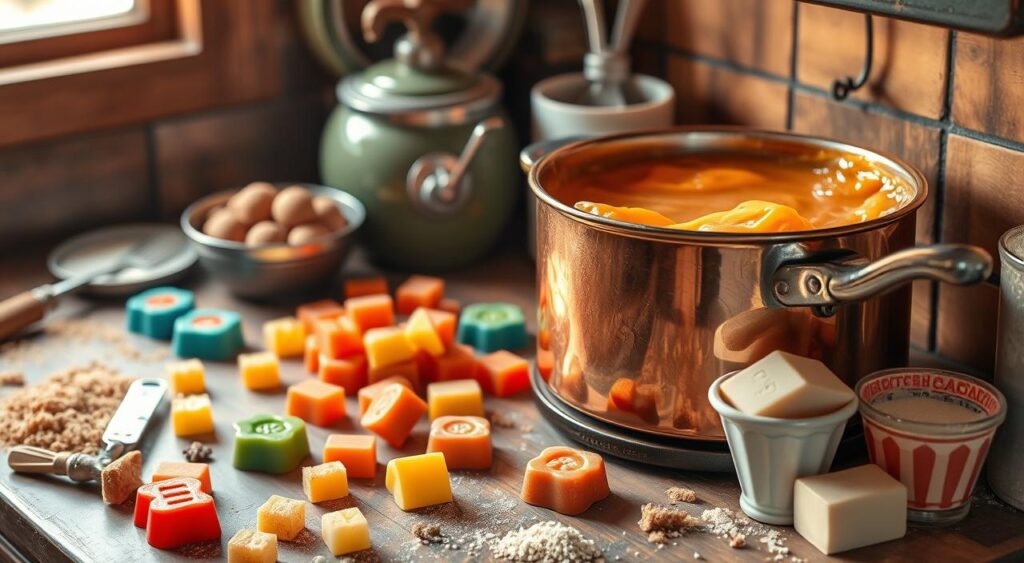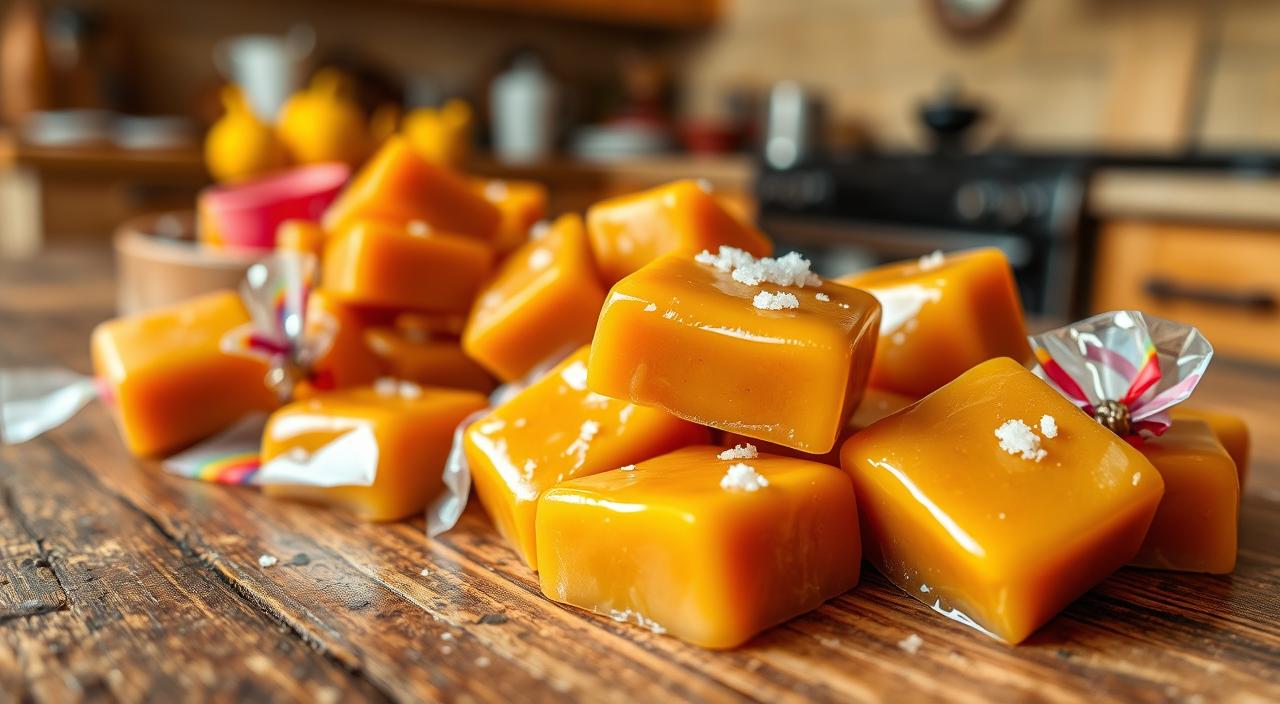As autumn leaves start to fall and the air gets cooler, nothing beats the smell of homemade butterscotch candy. It takes us back to happy childhood memories. The sweet, buttery taste is unforgettable.
Making your own butterscotch candy is surprisingly simple. You only need 7 ingredients and a few steps. It’s a treat that will make everyone happy, from your family to your friends.
Whether you’re experienced in making candies or new to cooking, this recipe is easy and rewarding. It combines the deep flavors of brown sugar with smooth butter. This homemade candy is far better than store-bought, making you feel proud and skilled.
Understanding the History and Appeal of Butterscotch

Butterscotch is a favorite treat with a long history. It was first made in 1817 in Doncaster, Yorkshire, England. It’s made by heating brown sugar and butter gently, creating a deep, rich flavor.
Origins and Traditional Recipes
The basic recipe for butterscotch is simple: just butter and brown sugar. These ingredients have been the core of butterscotch for years. Making it at home often results in a taste that’s better than store-bought.
Why Homemade Butterscotch Surpasses Store-Bought Versions
Store-bought butterscotch is convenient, but homemade is richer. Homemade butterscotch uses real butter and molasses, giving it a better taste and texture. Enjoying homemade butterscotch lets you experience the true taste of this classic traditional butterscotch.
“Butterscotch pudding is favored over vanilla and chocolate pudding, and butterscotch sauce is commonly used as a topping for ice cream and cheesecake.”
Essential Ingredients for Perfect Butterscotch Candy

Making homemade butterscotch candy requires top-notch ingredients. The main ingredients are brown sugar and butter. Brown sugar gives it a sweet, molasses-like taste. Butter makes it creamy and indulgent.
The Role of Brown Sugar and Butter
Butterscotch is different from caramel because it uses brown sugar. This sugar has molasses, which adds depth and a softer texture. Using good butter ensures the sugar melts well, making the candy smooth.
Additional Flavor Enhancers: Vanilla, Salt, and Honey
To make the flavor even better, add vanilla extract, a bit of salt, and some honey. Vanilla brings a warm, aromatic taste. Salt balances the sweetness. Honey adds a soothing warmth that enhances the other flavors.
Quality Ingredients Selection Tips
Choose pure vanilla extract and high-quality unsalted butter for the best taste. If you only have salted butter, use less salt. For a richer flavor, mix some light brown sugar with white sugar.
Required Tools and Equipment
When making homemade butterscotch candy, the right tools are key. They help get the perfect texture and flavor. Make sure you have these essential items for a successful butterscotch-making experience:
First, you’ll need a candy thermometer. It’s vital for checking the sugar syrup’s temperature. You want it to hit the hard crack stage of 295-300°F. A digital thermometer works well too.
Next, a baking sheet covered with parchment paper is crucial. Pour and spread the hot butterscotch mixture on it. The parchment paper keeps the candy from sticking to the pan as it cools.
Also, use a heavy-bottomed saucepan or Dutch oven for cooking. This pan spreads heat evenly. It prevents hot spots that can burn or caramelize the candy unevenly.
Lastly, a pizza wheel or sharp knife is needed. They help score and cut the cooled butterscotch into pieces. This makes it easier to portion and serve.
With these tools, you’re ready to make delicious homemade butterscotch candy in your kitchen.
Step-by-Step Preparation Process
Making homemade butterscotch candy is a fun and rewarding task. It lets you control the candy making, temperature, and cooking methods. First, get your ingredients ready: brown sugar, butter, cream, honey, salt, and vanilla extract. Keeping the temperature right is key to get the candy just right.
Proper Temperature Control Techniques
Begin by boiling a pot of water. Then, put your candy thermometer in it to check it’s at 212°F. This makes sure your thermometer is working well, which is important for the cooking process.
Mixing and Cooking Methods
In a big saucepan, mix the brown sugar, butter, and corn syrup. Heat it on medium, stirring all the time, until it hits 270°F. Then, add the honey, salt, and vanilla, and stir until it’s 300°F. Keeping the temperature steady is crucial for the candy making process.
Cooling and Setting Guidelines
When the candy hits 300°F, pour it into an 8×8-inch baking pan. Let it cool for about 5 minutes. Then, use a lightly oiled pizza wheel to score it. This makes breaking the candy into pieces easy. As it cools, the scoring helps it set into the right shape and texture.
Tips for Achieving the Perfect Texture
Making homemade butterscotch candy is all about getting the texture right. The secret to a smooth, creamy butterscotch texture is in the details during cooking. First, make sure the sugar dissolves completely to avoid graininess.
Keep the heat low and cook until the sugar is fully dissolved. This stops sugar grains from forming in the syrup. Adding a bit of corn syrup or extra honey can also help keep it smooth.
“The secret to the perfect butterscotch texture is all in the temperature control and ingredient proportions.”
If your candy is too hard to cut, warm it in the oven for 5 minutes. This softens the texture, making it easier to slice. By following these tips, you’ll get the classic butterscotch texture everyone loves.
Common Mistakes to Avoid When Making Butterscotch Candy
Making perfect homemade butterscotch candy needs precision and care. Even experienced candy makers can make mistakes. Knowing these common errors helps make sure your butterscotch is always great.
Temperature Control Issues
Getting the temperature right is key for butterscotch. The recipe wants it cooked to 236°F for the right chewy texture. If it’s too low, it won’t set right. Too high and it tastes burnt.
Having a good candy thermometer is vital. It helps you keep the temperature just right while cooking.
Ingredient Proportion Problems
Using the right amounts of ingredients is also important. The recipe needs 2 cups of brown sugar, ¾ cup of heavy whipping cream, 6 tablespoons of butter, and 1 cup of powdered sugar. If you get these wrong, your candy might be too soft or too hard.
Also, using fresh, quality ingredients is crucial. Make sure to use new, unopened brown sugar. This helps avoid texture problems. By focusing on the right amounts and fresh ingredients, you’ll make perfect butterscotch.
*1 in 10*: Statistic suggests the frequency of a particular mistake made when making butterscotch candy.
With practice and these tips, you can become a pro at making butterscotch candy. It’s all about paying attention to details. So, stay focused and enjoy the sweet fruits of your labor.
Creative Serving and Packaging Ideas
Homemade butterscotch candy is a tasty treat and a great gift. To make your butterscotch look special, try these creative ideas.
Decorate cakes or cheesecakes with your butterscotch for a sweet touch. Break it into pieces and add it to whipped cream-topped lattes. For gifts, put the butterscotch in airtight containers or wrap it in cellophane or parchment paper. Avoid using aluminum foil, as it can stick to the candy.
Use your butterscotch in baked goods like brownies, cupcakes, or butter cookies. Sprinkle it on ice cream sundaes for a tasty topping. Butterscotch is great for making many desserts better.
When packaging your butterscotch, use items like glass jars or tin containers. They’re charming, cost-effective, and add a personal touch to your candy packaging. Add a handwritten note or card to make your gift idea even more special.
Storage and Shelf Life
Keeping your homemade butterscotch candy fresh is key to enjoying it. Proper butterscotch storage and knowing its candy shelf life are crucial. This way, your kitchen efforts won’t be wasted.
Homemade butterscotch candy can stay fresh at room temperature for weeks. You don’t need to refrigerate it, as long as it’s in a clean, dry, airtight container. With the right preserving homemade candy methods, it can last up to a year.
“Properly stored, homemade butterscotch can last for weeks, sometimes even a year, depending on the storage conditions.”
To keep it even longer, freeze the butterscotch. Put it in an airtight container or freezer-safe bag. It will stay good for months. Just thaw it at room temperature before eating.
Always check the candies for spoilage before eating them. Look for any color changes or bad smells. With a bit of care, you can enjoy your homemade butterscotch for weeks or months.
Conclusion
Homemade butterscotch candy is a timeless treat you can make at home. It has a rich, creamy flavor and a delightful texture. This classic confection beats any store-bought version.
By learning simple techniques and using quality ingredients, you can make butterscotch candy that’s amazing. It will make your taste buds happy and bring back fond memories.
Homemade butterscotch candy is perfect for a sweet snack or a heartfelt gift. You can enjoy it on its own, add it to baked goods, or drizzle it over ice cream. Making butterscotch candy at home is a rewarding experience.
So, get your ingredients ready, turn on the stove, and let the aroma of homemade butterscotch fill your kitchen. Enjoy every bite of your homemade creation. You’ve mastered the art of making this classic homemade butterscotch, perfect for satisfying your sweet treats cravings or sharing with loved ones as an easy candy recipe.
FAQ
What are the key ingredients in homemade butterscotch candy?
To make homemade butterscotch candy, you need brown sugar, butter, white sugar, water, vinegar, salt, and vanilla extract.
What are the nutritional facts for homemade butterscotch candy?
Homemade butterscotch candy has 31 calories per serving. It contains 1g of fat and 5g of carbs.
What tools and equipment are needed to make butterscotch candy?
You’ll need a baking sheet lined with parchment paper, a heavy-bottomed pan, a candy thermometer, and a pizza wheel for scoring.
What is the proper temperature for cooking butterscotch candy?
Cook the sugar mixture to 270°F, then to 300°F, stirring constantly.
How can I prevent the butterscotch candy from becoming grainy?
To avoid graininess, make sure the sugar dissolves completely. Keep the heat low. Use corn syrup or extra honey to prevent crystallization.
How should I store homemade butterscotch candy?
Store the candy in an airtight container at room temperature. It can last for weeks without refrigeration.
How can I use homemade butterscotch candy?
Use the candy to decorate cakes or cheesecakes. Additionally, sprinkle it over whipped cream-topped lattes. You can also add it to brownies, cupcakes, yogurt, or butter cookie dough.
